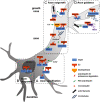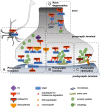The Ubiquitinated Axon: Local Control of Axon Development and Function by Ubiquitin
- PMID: 33789876
- PMCID: PMC8018891
- DOI: 10.1523/JNEUROSCI.2251-20.2021
The Ubiquitinated Axon: Local Control of Axon Development and Function by Ubiquitin
Abstract
Ubiquitin tagging sets protein fate. With a wide range of possible patterns and reversibility, ubiquitination can assume many shapes to meet specific demands of a particular cell across time and space. In neurons, unique cells with functionally distinct axons and dendrites harboring dynamic synapses, the ubiquitin code is exploited at the height of its power. Indeed, wide expression of ubiquitination and proteasome machinery at synapses, a diverse brain ubiquitome, and the existence of ubiquitin-related neurodevelopmental diseases support a fundamental role of ubiquitin signaling in the developing and mature brain. While special attention has been given to dendritic ubiquitin-dependent control, how axonal biology is governed by this small but versatile molecule has been considerably less discussed. Herein, we set out to explore the ubiquitin-mediated spatiotemporal control of an axon's lifetime: from its differentiation and growth through presynaptic formation, function, and pruning.
Keywords: axons; neuronal disorders; presynaptic terminal; ubiquitin; ubiquitin-proteasome system.
Copyright © 2021 the authors.
Figures



References
-
- Angelman H (1965) 'Puppet' Children a report on three cases. Dev Med Child Neurol 7:681–688. - PubMed
Publication types
MeSH terms
Substances
LinkOut - more resources
Full Text Sources
Other Literature Sources
